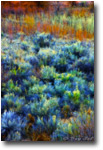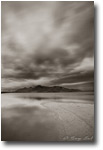 |
 |
||||
These questions cut to the very core of why we do what we do. Surely there are many of us engaged in photojournalism, sports photography and stock photography where a faithful representation of the subject is required and implied, but what about those images we make for aesthetic purposes, to create and inspire emotion, to communicate complex visual messages, to promote a deeper understanding of our subjects, of ourselves, beyond the literal objects portrayed? I ask these questions because of the apparent movement to impose arbitrary limitations and draconian rules and definitions on what constitutes “Nature Photography”, as if all Nature Photography has but one role in this world - to serve a simple purpose of documenting natural-looking subjects. Surely this applies in many cases, but is that all there is to it? And if so, where is the art? I am saddened to see so many fellow photographers rush to voluntarily adopt and support initiatives such as FoundView or TrustImage without considering their implications to the photographic community as a whole. It is one thing to like chocolate cake but an altogether different thing to require that all other food be labeled as “not chocolate cake”. To define Nature Photography in terms of a “true” (whatever that is) representation of a scene is quite simply stating that Nature Photography is devoid of ulterior meaning – of emotion, of spirituality, of mystery, of personal interpretation, and thus cannot be a form of art. Art implies artistic freedom. The aim of art is to represent not the outward appearance of things, but their inward significance. –Aristotle I recently read the submission guidelines for a prestigious Nature Photography competition with great distress. Prints and negatives are not accepted, only minor post-processing is allowed, submissions must represent the image as captured in-camera and in some cases with a raw file as evidence. After careful reading of the rules it dawned on me that Ansel Adams could not enter this contest; neither could Edward Weston, Eliot Porter, William Henry Jackson, and a long list of other monumental figures who defined the genre. Considering the images I had planned to submit myself I was only somewhat consoled by the fact I was in such good company. We all know that art is not truth. Art is a lie that makes us realize the truth. –Pablo Picasso While some of the above can be attributed to ignorance or misinformation about the finer points of artistic photography as distinct from photography for documentary purposes, even more disturbing to me are those who proclaim themselves artists and make it their business to denigrate other forms of art as less worthy than their own. In the history of art, the sole reliance on being “different” or “original” had long been the crutch of the untalented. Surely there are many who appreciate what to me is obscure, shocking, and bland works. I don’t generally go out of my way to proclaim what is or is not art – as far as I am concerned it is in the eye of the beholder. On the other hand I consider it self-damning when one feels a need to de-legitimize the art of others to draw attention to their own. Further to blame are those who associate the value of an image with the equipment or technique used to create it. Like most photographers, I also share a fascination with the instruments that make our work possible. Like many, I also strive to achieve the highest standards of quality and technical perfection and to hone my skills at using these tools to their utmost potential. Still – these all take a back seat to the final product. An image lives or dies by the reaction it evokes in the viewer. At that point all the work, all the technology, all the skill, and all the gear specs become moot. The finished image either stands on its own or it doesn’t, and no amount of techno-babble will make an image great that is not. So who’s to say what “art” is? I certainly do not consider myself worthy of setting a standard, nor do I think one can or should be set. Like Philosophy, art is not a singular well-defined concept. To me art begins when a creative work goes beyond merely representing reality and enters the realm of personal expression. It is the use of tangible elements to create meaning beyond their literal portrayal. This seems to be the exact opposite of what many are attempting to enforce on Nature Photography these days. Art to me is not about representing the ordinary, not about perpetuating the mundane, nor about arousing anger, disgust, or protest. Life gives us enough of these on a daily basis and anyone hungry for more needs only to turn on their television set. Art to me is also not about simple self-evident messages like “here’s a flower”, or “this is what I saw out my car window”. Like all forms of communication these have their place, but this does not make them art. Art needs to be different from, greater and more meaningful than a straightforward representation of a random moment in time. Did Rembrandt try to produce ugliness? Did Shakespeare try to use everyday language? Did Puccini run away from a beautiful sonata? Did Dostoevsky shun deep insights? Did Picasso avoid surprise? Did Beethoven sidestep the dramatic? Did Twain shy away from sharp-tongued comments? Did Frank Lloyd Wright shun stunning new ways to meld natural and human interruptions? Will any of these artist's be remembered? Of course! They will be remembered because they were true artist's who produced singularly striking works of art in their fields by remaining true to the essence of art. – Bruce Barnbaum Consider this a call to arms – if you believe in Nature Photography as a form of art (whether you consider yourself an artist or not) – do not give in to those who seek to constrain and define and regulate all Nature Photography towards one single purpose. Stand up to those preaching bigotry against personal expression through Nature Photography, say “thanks but no thanks!” to the likes of FoundView and TrustImage, write to, and even boycott, organizations, editors and sponsors of magazines and photo competition who claim to represent Nature Photography whose rules are so rigid and out of touch with the genre that even the greatest nature photographers in our history could no longer qualify for them. And most of all – do not be swayed by those preaching a passing fad and proclaiming your work not worthy. Stand up for your art! No great artist ever sees things as they really are. If he did, he would cease to be an artist. –Oscar Wilde GT-NPN 0440 Comments on NPN landscape photography articles? Send them to the editor. Guy Tal resides in Utah, where most of the Colorado Plateau's breathtaking grandeur can be found, and where issues of preservation and land-use are among the most prominent on the political agenda. Guy's large format photography can be viewed on his website at http://scenicwild.com. | |||||
|
|
|||||

